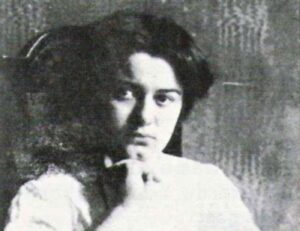The French Impressionist Pierre-Auguste Renoir was not only a prolific creator of gorgeous art, but was a passionate, zealous advocate of creativity itself. The serene, sensitive film Renoir (2012) by Gilles Bourdos attempts to match Renoir’s lyrical use of color with the lushness of a luxuriously paced film. Much of the out-of-focus, hazy cinematography is designed to mimic the lush, impressionistic look of much of Renoir’s paintings. Many shots bathe the screen in the iridescent golden glows of the midday sun. Speckles of light and vibrant colors seep onto the screen in a manner similar to the way they decorate Renoir’s paintings.
The film is worth watching not only for its beautiful visual effects, but also for its powerful expression of Renoir’s implicit theology of creativity—a theology that has surprising parallels with the thought of influential Jewish thinkers.
At the film’s opening, Pierre-Auguste worries that his sons Claude and Jean are not involved in valuable work. “They don’t create anything lasting,” laments Renoir, “a pair of shoes, a book, a table . . . something people can hold in their hands.”
Even before he became a painter, Renoir strove to create objects that could last. As a child, Pierre-Auguste made pottery in a porcelain factory. Creativity was always foremost in his consciousness; it was his raison d’être. If his sons were to embark upon paths in which they would not be creative—Pierre was pursuing an acting career and Jean went on to become the famed director of cinematic masterpieces such as The Rules of the Game and The Grand Illusion—if they did not lead lives in which they created lasting objects that others could “hold in their hands,” Renoir feared that they would be wasting their lives.
Start your day with Public Discourse
Sign up and get our daily essays sent straight to your inbox.The loosely structured, nearly inconsequential plot of the film centers on the budding relationship between Jean, who is on medical leave from the French army during the First World War, and Renoir’s new model, Andrée. Every artist needs a muse—whether the muses are other works of art (as they were for Yeats), dreams (as they were for Edgar Allan Poe), or God (as He was for the ancient Israelite poets who attributed their wondrous literary creations to divine inspiration). For Renoir, who loved to paint the female nude, his muse was a woman. Or, more precisely, his muses consisted of an alternating cast of younger and younger models; when his models became too old, they were demoted to the Renoir housekeeping staff.
While Renoir was an artist and not a theologian, the theology that is implicit in Renoir’s approach to life and to art reflects the centrality of creativity to his thinking. Renoir’s theology, it seems, was art: just as his lines lent his paintings their form, art endowed his life with structure. And much as his art enriched the lives of others with beauty, art lent his own life a transcendent significance. By creating beautiful objects of lasting value, art allowed him to feel that he was using his artistic gifts in the most beneficial, dignified way possible. To live a meaningful life, for Renoir, was to create.
Renoir possessed a deep-seated belief that existence was rendered meaningful through creativity. Renoir had to paint; for Renoir, the stakes of art were almost yehareg v’al ya’avor—do or die. If he could not paint, he did not want to live. In the middle of the film, we see him struggling mightily just to walk a few steps. “I give up,” he says. He was suffering from cripplingly painful rheumatoid arthritis, and needed to exercise in order to manage his pain. “Walking takes all my strength,” he bitterly states, intimating that he wishes to give up the trying regimen. “I won’t have anything left for painting.”
“And if you can’t use your hands?” his assistant asks.
“I’ll paint with my dick.”
This line may be said for laughs, but it encapsulates an entire realm of thought in which creativity is sexualized, and in which the creative process is viewed as a generative act. If human beings are commanded (or blessed, according to what is perhaps the literal meaning of the verse) to “be fruitful and multiply” (Genesis 1:28), one such manner in which this verse can be fulfilled, according to theopoetic theologians, is to be artistically fruitful and create lasting works of art that fill the world with beauty. “The Renoirs refused to paint the world black,” the film tells us. For the Renoirs, the imperative of painting was to make the world beautiful: “There are enough unpleasant things in life. I don’t need to create any more.”
Creativity as a theology is not confined to artists alone; it is also the theology that animates some of the most influential Jewish thinkers of the past half-century. According to Joseph B. Soloveitchik, God created human beings in His image so that they would partner with Him in perfecting His unfinished world. To be in the image of God, according to Soloveitchik, means to possess some of the capacities of God. Invoking the Talmudic concept of sh’lucho shel adam k’moto (the idea that one’s agent must be like oneself), Soloveitchik explains that God was “legally” able to select human beings as His agents because only human beings possess the God-like capacities of the Sender. And foremost among these capacities is the creative capacity.
Being in the image of God, according to Soloveitchik, means that human beings possess a God-like creative capacity. To exercise that capacity is to actualize one’s own inner godliness; not to exercise this capacity is to fail to realize one’s potential as a creature in the image of God. The “concept of the obligatory nature of the creative gesture—of self-creation as an ethical norm, an exalted value”—was an idea that “Judaism introduced into the world,” writes Soloveitchik. The stakes are great, and Renoir appears to have been catalyzed by this notion.
Soloveitchik believed that human creative powers were best utilized in the service of chidush: novel interpretations of text. Renoir believed that human creative powers were best utilized in the service of painting—and if one couldn’t paint, then in making shoes, in binding a book, or in crafting a piece of pottery—in creating something that a person could hold in his or her hands, “something that would last.”
Soloveitchik, though, also believed that human beings must use their creative capacities on their own selves: “God wills man to be a creator—his first job is to create himself as a complete being.” And, as Abraham Joshua Heschel stated toward the end of his life, one should “build a life as if it were a work of art . . . Start working on this great work called your own existence.” As far as Pierre-Auguste was concerned, the process of creating art was the means through which one achieved self-creation.
As the elder Renoir was in painting, so was his son in film: the acclaimed director Jean Renoir created himself by crafting artistic films of enduring cinematic value. Even though he was destined to become one of the greatest directors of early cinema, Jean Renoir himself doubted whether film could ever be “artistic.” During the film, we hear Jean expressing profound concern about whether film could ever approach the aesthetic and intellectual plane of painting. “Film is not for us French, it’s for the masses,” he worries about his chosen field of art. “We have too much artistic baggage.” Yet, with triumphs of the celluloid such as La Règle du jeu, he would go on to prove himself—and other early cinema skeptics—startlingly wrong.
Jean Renoir and the film Renoir alike make the argument that a film, just as much as a painting, can be a lasting work of art. An actor who creates a poignant theatrical performance with his or her voice, body, and gestures, and a director who captures these actions on film, edits them, and shapes them into an aesthetically valuable work of cinema, engage in creative acts as significant as the art of painting. And indeed, just as Pierre-Auguste Renoir’s paintings have lasted, Jean Renoir’s films have endured the test of time. Both have become works of art that people can “hold in their hands.”
“You can’t understand painting,” said Renoir. “You have to feel it.” After viewing Renoir, one goes from merely understanding the painter to nearly achieving a sensuous feeling of the great sui generis Impressionist himself.











